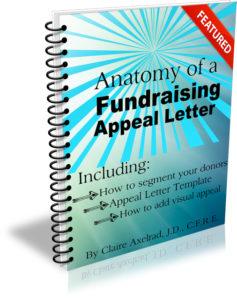 Fundraising copywriter extraordinaire, Lisa Sargent, recently shared a brilliant piece of writing on the Moceanic blog. Appropriately, the subject matter – “6 Winning Ways to Start Your Next Fundraising Appeal” — was all about brilliant writing. Specifically, fundraising appeal writing. I commend the full article to you, as she fills it with juicy, specific examples. But if you’re short on time, here are the key take-aways – plus some of my own thoughts and examples — to get your reader well “into” your appeal – right from the get go!
Fundraising copywriter extraordinaire, Lisa Sargent, recently shared a brilliant piece of writing on the Moceanic blog. Appropriately, the subject matter – “6 Winning Ways to Start Your Next Fundraising Appeal” — was all about brilliant writing. Specifically, fundraising appeal writing. I commend the full article to you, as she fills it with juicy, specific examples. But if you’re short on time, here are the key take-aways – plus some of my own thoughts and examples — to get your reader well “into” your appeal – right from the get go!
Next time you’re staring at a blank piece of paper, try BEGINNING with:
The first line’s job: Get the reader to the second line. Otherwise, all your carefully crafted prose is for naught. The first line ideas below are tested and true; you can’t go wrong with any of them. Just switch them up so that not every one of your appeals starts the same way. Why? Because (1) not every style is your best bet for every situation, and (2) not all your readers are alike. Some prefer whodunnit mysteries, others prefer coming of age tales, and others historical fiction. Still, everyone will respond to a good story.
Everyone.
An appeal without a story is a true crime. As business and thought leader Jim Collins taught us:
“We are known by the stories we can tell.”
So, before putting pen to paper, think about a story you can tell. Only then should you begin. When you do, use Lisa Sargent’s conceptual framework.
1. “Start with a surprising detail.”
I worked for a food bank once upon a time, and would start an appeal with:
“Six-year-old Billy lives in San Francisco, one of the richest cities in the world. Yet he cried himself to sleep last night, because he was so hungry. This wasn’t the first time. It won’t be the last.”
UNLESS…The rest of the letter went on to explain how Billy’s situation would remain dire, unless the donor helped. Donors often told me how surprised they were to learn anyone, let alone a small child, went to bed hungry in our city.
2. “Frame it with a possibility question.”
Let’s go back to the food bank for an example.
“What if the food pantry hadn’t been there for Billy and his family that week?”
You could also begin with a surprising fact, but make sure if you do so you follow the question immediately with the story of one child.
“Did you know 1 in 4 children in San Francisco don’t have enough food to grow and thrive?”
You want the reader to easily begin to visualize why this would have been a huge problem – even greater than they’d imagine. As Mother Teresa famously said:
“If I look at the mass I will never act. If I look at the one, I will.”
3. “Get granular.”
I pulled this opening from one of the best fundraising letters of all time, shared on the SOFII showcase.
“A lady should never get this dirty, she said.
She stood there with a quiet, proud dignity. She was incomparably dirty – her face and hands smeared, her clothes torn and soiled. The lady was 11.”
This granular detail speaks volumes about why help is needed.
4. “Harness the power of imagination.”
When you use “Imagine this” or “Picture this,” you immediately get your reader visualizing something, or someone, triggering empathy. This motivates people towards kindness and generosity. Here’s a letter I found on a another SOFII showcase.
“Could you picture, for a moment, a woman on the brink of making the hardest decision of her life?”
A variation on this is often used to remind alumni what it was like to be a student. If they can connect to those feelings, they may be inspired to pay it backwards so others can experience the same joys. Or avoid the same sorrows.
“Remember how the campus looked, and felt, in the early days of autumn?”
Or you can simply cut to the chase with an opener like this one from another winning, imagination-harnessing appeal shared on SOFII:
“There is absolutely nothing worse than watching your three-year-old child die.”
5. “Use the situation as the story.”
If something is the lead story in the news, you can trust your donors are thinking about it. In this case, the situation is the story. It’s top of mind for your readers, and they’re predisposed to read about it. In other words, it has immediate relevancy.
During the Covid pandemic a lot of fundraisers simply led with:
“Join the emergency response today, so no one suffers needlessly.”
It works, because you’re telling it like it is. It’s authentic, and aligns with people’s values and current priorities.
6. “Start with ‘I’m writing to you’…”
“I’m writing to you today because I want to share a story.”
“Because” increases success by over 30% and is a powerful trigger for acquiescence. And, remember, people want to read stories! So this is a doubly powerful appeal intro.
“Please, it’s vital that you read this letter.”
This line began another of the best appeal letters of all time on SOFII. It draws people in because they want to know WHY you’re writing.
Never begin an appeal with the equivalent of “We do all sorts of good stuff… we’ve a lot to be excited about this year… funding is essential… blah, blah…” The reader won’t understand why you’re bothering to write to them. “We need money” is not enough of a reason. Without a why – an outcome (not monetary) goal – there’s no happy ending the donor can provide. They won’t feel inspired, or needed.
HINT
If you’ve already got a first draft, or an appeal from last year, take a fresh look. You’ll often find your best first line two or three paragraphs down the page. That’s because we have a tendency to take too long to warm up and get to the point. Don’t do that! If you do, you’ll lose your reader before they get to the good, compelling stuff. Thanks again to Lisa Sargent for all these great tips!
Want to learn more about effective fundraising appeal writing?
 Grab my Anatomy of a Fundraising Appeal + Sample Template. This is a simple, yet incredibly thorough, 62-page step-by-step guide to crafting a killer appeal letter or email appeal. It’s not just a breezy 2-page form, like what you’ll find elsewhere. Because writing a compelling fundraising letter can be tricky. It’s not the same kind of writing as a brochure, annual report or grant proposal. But it’s not rocket science – it’s something you can easily learn. It’s just not something most of us are taught. And that’s where this nifty e-Guide comes in!
Grab my Anatomy of a Fundraising Appeal + Sample Template. This is a simple, yet incredibly thorough, 62-page step-by-step guide to crafting a killer appeal letter or email appeal. It’s not just a breezy 2-page form, like what you’ll find elsewhere. Because writing a compelling fundraising letter can be tricky. It’s not the same kind of writing as a brochure, annual report or grant proposal. But it’s not rocket science – it’s something you can easily learn. It’s just not something most of us are taught. And that’s where this nifty e-Guide comes in!
Not satisfied for any reason? No worries. You have my no-questions-asked, 30-day, 100% refund guarantee. Now… onward and upward to fundraising appeal success!
Photo by Markus Winkler on Unsplash





